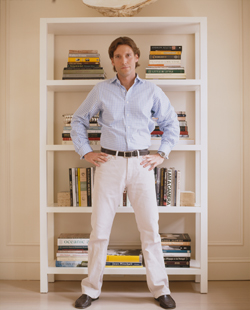Decorating the Reader's Den
By Traci Vogel

As more and more literature goes digital, at least one haven for paper remains: the home library. To New York-based interior designer Timothy Whealon '88, a room without books is unfinished. He builds many of his modern-yet-timeless interiors around his clients' collections. The art and furniture might all be in place, but "the room is not complete until the bookcases are filled," he says.
Whealon, an English major at Kenyon, views books as both beautiful decorative objects and windows into personality. When he wants to understand clients better, he talks to them about what they're reading, and his clients often buy books for him to help him understand their aesthetic.
"Books are my way of getting to know people, to get their essence," he says. "I also like the way books create their own space. They're part of the interior themselves—they're three-dimensional objects with weight and heft."
His own collection is a case in point. Though currently renovating a new apartment in New York's Gramercy Park, in his former space on Fifth Avenue Whealon displayed his library in étagères, free-standing open-sided cabinets. On the shelves he stacked his books in horizontal pyramids, mixed with one or two objects, such as a simple vase or box. The arrangement merited a cover on Elle Décor magazine.
The designer recommends allocating a space dedicated to books in your home. "Think about it in the scheme of the room when you're designing it," he suggests. "Books need a home just like your clothes need a home." For his clients, Whealon often creates built-in bookshelves, but he also places books around a room, piled on coffee tables or library tables.
How books are grouped is an important consideration for the home decorator. "You have to allocate hardcover versus paperback," says Whealon. "Your eye wants some kind of order." Once you've organized your books by size to create a shape and structure, you can add objects to the mix. For one client whose children enjoyed reading before bedtime, Whealon created a library alcove on a stair landing. In the design, the colorful covers of the children's books are complemented by throw pillows and toys tucked into the shelves.
"I think the spines of books are beautiful, and can have a rhythm to themselves, and a life," says Whealon. This is one of the reasons he doesn't think the paper book is going away any time soon. “In a way, they're like fine art," he says. "There's the tactile element, opening up this narrative, looking at the pictures, the smell, the whole three-dimensionality."
No, he says, like furniture, "Books will persevere."

 Delicious
Delicious Facebook
Facebook StumbleUpon
StumbleUpon Digg
Digg reddit
reddit